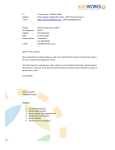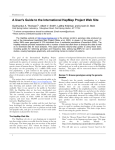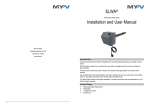Download Consumer Guide Solar PV - Barbados Renewable Energy Association
Transcript
Consumer Guide Solar PV Helping you choose the right solar PV solution and avoid potential pitfalls BREA -‐ Barbados Renewable Energy Association www.barbadosenergy.org What’s the difference? Solar hot water systems These convert the free suns rays into heat to warm our water! Thanks to the world renowned success of Barbados’s solar water heating industry, Barbadians have already been saving millions of dollars a year on their energy bills by using this technology. vs Solar PV systems These work on the quantum level to convert free sunlight (or more precisely the photons of electro-‐ magnetic energy that make up the sunlight) into electricity. PV is short for Photovoltaic, derived from ‘photo’ [light], and ‘voltaic’ [electricity] Page 2 of 26 Table of contents Why go solar? .......................................................................................................................... 4 First step: Use less electricity! .................................................................................................. 5 Types of solar PV systems ........................................................................................................ 6 How a grid-‐connect system works ............................................................................................ 8 How an off-‐grid system works .................................................................................................. 9 Solar PV system components ................................................................................................. 10 Solar PV installation considerations ....................................................................................... 15 Lifetimes of grid connect solar PV systems ............................................................................. 16 How big should your PV system be? ....................................................................................... 17 Financial information ............................................................................................................. 19 Know what questions to ask .................................................................................................. 21 Additional tips when shopping for solar PV ............................................................................ 22 About us ................................................................................................................................ 24 Best advice? … Don’t be too mesmerised by price. Probably the greatest thing about solar PV is that it is an investment that will most likely save money in the long run… BUT… only if you invest in a good quality, well installed system. A PV system should last for over 25 years with minimum maintenance, but only if it is correctly installed using quality products throughout (i.e. not just PV panels and inverter but the cables, switches, racking, etc.). Continue reading to learn more about solar PV and how it can save you money. Page 3 of 26 Why go solar? Solar PV systems are already collectively saving their Barbadian users over $5 million a year on their electricity bills (equivalent to 5,000 barrels of oil, or over 2,000 tonnes of CO2 emissions). Apart from giving PV system users the opportunity to generate their own electricity, a solar PV system addresses issues relating to the island’s extremely high fuel import bill as well as its impact on the environment. Because they have no moving parts, solar PV modules (the most expensive part of a PV system) are extremely reliable and have an expected life span of more than 25 years. They are also easy to install and require very little in the way of maintenance. Barbados… the perfect place for solar PV Germany currently has the highest amount of installed solar PV/person in the world. However if you take two identical 1.5 kW PV systems, one installed in Germany and the other in Barbados, the Barbados system will generate 60% more electricity over the course of the year! Who should really have the highest installed capacity per person? Current level of PV installation Germany – 400 Watts/capita Barbados – 40 Watts/capita Monthly energy yield of identical 1.5kWp PV systems installed in Barbados and Germany Page 4 of 26 First step: Use less electricity! Before installing a PV system it is important to explore energy efficiency options first -‐ the reason being that most of these energy efficiency options will have a much shorter payback than a PV system, which typically pay for themselves in reduced electricity bills in around 5-‐7 years. Taking energy conservation action first will also mean that your energy consumption is reduced and you can install a smaller (and therefore cheaper) solar PV system. After all… “The greenest power is the power you don’t have to produce” The high cost of electricity here in Barbados has taught a lot of us to be frugal with our electricity use, but there are still many things we can do to lower our energy bills, including: - The single best thing we can do to use less electricity is for us to change our energy habits – its best to create ‘energy efficient’ people, as well as install ‘energy efficient’ products. There are products that can help us achieve this such as installing a digital energy monitor. This is an excellent way to make us more aware of our energy use and improve a family’s energy habits. After all, it’s not our homes that consume electricity; it's the people inside our homes! - Install energy efficient lighting. Unlike compact fluorescent lights (CFLs), modern energy LED light bulbs are now able to provide a similar colour of light to the old incandescent light bulbs that we are all used to and like. You might be surprised by just how much LED light bulbs have developed in recent years. Installing LED lighting is quick and easy (as easy as changing a light bulb!), and you will see savings right from your next electricity bill (savings from 50% to as much as 90% of your lighting costs can be achieved). LED lighting is more expensive than conventional lighting but the substantial savings in electricity consumption mean that payback can be in a matter of months. - If you use hot water and don’t have a solar water system, get one! Barbados has an internationally recognised solar water heating industry but you may be surprised to learn that around 60% of homes still do not own a solar water heater. If you are currently using a gas or electric immersion heater, installing a solar water heater will pay for itself in savings within 3 years… and you are supporting local industry! - Replace old appliances with more energy efficient appliances. For example, a front-‐ loading washing machine will use approximately half the electricity that a top loading washing machine uses (and approximately half the water). Often the biggest energy user in your home is the fridge/freezer. That white unobtrusive cupboard in the corner of your kitchen could slowly but surely costing you around $1,000/year to run. When replacing old fridges, new fridges with BNSI’s ‘Barbados Energy Labels’ can pay for themselves in energy savings in less than three years! - The Barbados National Standards Institute (BNSI) is working to help Barbados reduce its energy use in the residential sector by 24%. See overleaf to learn more about the BNSI and their energy label initiative. A list of the BREA members who are involved with energy efficient appliances and solar water heating can be found at the back of this guide. Page 5 of 26 Barbados Energy Labelling Programme The Barbados National Standards Institution (BNSI) is seeking to increase the energy efficiency in the residential sector of Barbados by introducing energy efficiency labels and standards for major electrical household appliances, lighting equipment and other electrical household products. Labels enable consumers to make informed purchase decisions. Standards prevent inefficient equipment from being imported. Energy efficiency standards and labels contribute to energy saving. Households, particularly those in the lower income bracket, commerce, industry and the public sector benefit from lower electricity bills. At the same time, the country benefits from lower fossil fuel imports. A reduction in the burning of fossil fuels contributes to environmental protection and climate change mitigation. The BNSI, its partners, other interested stakeholders, policy makers, importers and retailers of electrical equipment are working towards the following objectives: 1. Increasing knowledge of energy efficiency of domestic appliances 2. Development of the necessary standards, policies and legislation 3. Equipping the relevant institutions with the capacities to implement the standards. The programme also aims at raising the awareness of energy efficiency among the general p ublic and educating consumers about energy efficiency labels and their implications. For more information regarding this programme or if you have any questions please contact us or visit our website at <www.bnsi.bb>. Page 6 of 26 Types of solar PV systems There are two main types of solar PV systems: • Grid-‐connect (sometimes called grid-‐tie), and • Off-‐grid (sometimes called stand alone/remote power). A grid-‐connect installation ensures you have the electricity you need, whenever you need it -‐ automatically and regardless of weather conditions. With a grid connect system your property is still connected to the electricity grid for periods such as during the nighttime, when solar electricity production is not possible. An off-‐grid solar PV system is completely separated from the utility and is usually more expensive to install and maintain, as it requires the use a battery bank to store electricity for when the sun isn’t shining. However, developments in battery technology mean that battery costs are falling, and off-‐grid systems are not subject to changing energy prices or utility agreements so some PV users like the independence that homemade energy production offers. Solar PV is short for solar photovoltaic. Solar PV panels can convert sunlight directly into DC electricity, quietly and reliably for more than 25 years. Page 7 of 26 How a grid-‐connect PV system works 1. Solar panels directly convert sunlight into direct current (DC) electrical energy. 2. The inverter converts the solar DC power into alternating current (AC) ready to be fed back into the grid or used in your home. 3. AC power from the inverter goes through the main panel for use in your home. 4. Energy efficiency lighting and appliances receive power either from the solar panels or from the grid. 5. The meters record the energy sent to the grid from your solar system (i.e. the production meter) as well as the energy consumed from the grid. 6. Any surplus electricity being generated is automatically exported into the mains grid for use elsewhere. Note: To protect electrical linemen, if there is a utility power outage normal solar PV systems will stop working. You could buy a more expensive ‘bi-‐modal’ inverter with batteries, which can continue to operate during blackouts. A simplified representation of a grid-‐tie PV system. Most people currently going solar invest in grid connect systems. DC electricity from the solar panels is converted into an AC supply suitable for domestic appliances via the use of an inverter. Whenever the system produces more power than is being used, the surplus is fed into the utility grid. As you are then exporting power to the utility, BL&P will pay you for every kilowatt-‐hour of electricity your solar system feeds into the grid. In essence, the utility can be used as a storage system because when your solar system isn’t producing energy -‐ for example, at night -‐ the mains power grid supplies the electricity, as usual. Page 8 of 26 How an off-‐grid PV system works 1. Solar panels convert sunlight into direct current (DC) electrical energy. 2. DC electricity flows to the batteries via the charge controller/regulator, which prevents the batteries overcharging. 3. The battery bank allows you to collect energy during the day and store it until you need to use it. These can be installed either inside the house or in an external battery shed. 4. The inverter changes the battery DC power into alternating current (AC) ready to be used in the home. 5. Energy efficiency lighting and appliances receive power either from the solar panels or from the grid. A simplified representation of an off-‐grid PV system. Off-‐grid systems are battery-‐based systems. Instead of feeding the excess energy to the utility grid, it is stored in batteries for use when there is no solar energy available (e.g. after sunset!). Homeowners can choose to keep their utility connection in case the solar PV system is down for maintenance. Page 9 of 26 Solar PV system components The core components of a grid connect solar PV system are the panels, inverter and mounting system. For Off grid solar PV system there is the addition of batteries and a charge controller. Solar panels Solar panels come in different power ratings and sizes. As a rough guide, each solar panel is approximately 1.7 metres long and 1 metre wide. A typical 3kW solar panel system requires around 24m2 (260ft2) of roof space and a 5kW solar panel system requires around 40m2 (430ft2). There are 3 main types of solar cells used in solar modules… Monocrystalline panels offer high efficiencies (typically around 20% for commercial modules) and good heat tolerance characteristics in a small footprint. They are usually the most expensive type of module and are used in situations where space is limited. Multicrystalline (or polycrystalline) panels are now the most popular choice in residential installs. Recent improvements in Multicrystalline panel technology have resulted in the development of modules equal to or better than many monocrystalline brands in terms of size, efficiency and heat tolerance (typical efficiencies for commercial modules around16%). Thin-‐film modules use the least amount of material (and are sometimes known as ‘second generation’ solar modules). There are different types of thin-‐film technologies, and these are classified according to the material from which they are built e.g. amorphous silicon (aSi), Cadmium Telluride (CdTe), copper indium gallium diselenide (CIGS). Their typical efficiencies vary from 6 to 14% depending upon the type of thin-‐film technology being used. Even within any of the above technologies, performance between brands will vary. For example, some will perform better than others on hot days. With heat being the enemy of a solar panel (as temperature increases, efficiency decreases) and seeing as thought Barbados experiences more than its share of hot conditions, being aware of the differences is important. Note: Don’t pay too much attention to the rated efficiency of different types of solar modules described above. Efficiency is only really of concern if you want to produce the maximum amount of energy from the smallest amount of area. Other factors are more pertinent to choosing a solar module (such as dollars per watt (the cost divided by the rated power of the module, and the quality of the product). Page 10 of 26 What influences the cost of a solar panel? The cost of a solar panel varies greatly and is determined in part by its power output capacity (in watts), the physical size, the brand, the durability/longevity (or warranty period) and any certifications the solar panel might have. Choosing a solar panel on price alone is not wise, as it may not be suited to the area where you wish to install it, and may not provide the performance required to assist economic payback. When to buy? There is often uncertainty as to whether to invest in solar PV now, or wait to see if the market price for solar PV will continue to fall. In recent years, the global price of PV modules has fallen substantially (see figure below). However this price has levelled off in recent years, and is predicted to remain roughly constant over the next few years [Source: NREL in the US]. Global module price index (historical and predicted) Note: The above graph is the cost of manufacturing just the solar PV module and does not include the cost of other parts of the PV system (such as the inverter, racking system, additional components, installation, etc.). Page 11 of 26 Not all solar panels are equal! When choosing a solar panel it is important to consider both how it is manufactured and what materials are used. There are three tiers of manufacturer quality and BREA recommends you only use suppliers of tier 1 and tier 2 manufactured products. Tier 1 manufacturers • Control each stage of manufacturing process • Use highest grade silicon (the higher the grade of silicon – the better the solar panel) • Panels are built to internationally recognised standards Tier 2 manufacturers • Doesn’t necessarily mean that they’re producing a sub-‐standard product • Not fully integrated so no control over the whole manufacturing process • Lot of tier 2 manufacturers produce good products at a good price • Panels are built to internationally recognised standards Tier 3 manufacturers • Normally smaller/less advanced • Not as much control over what they use in their product • Panels are not always built to internationally recognised standards • Not the best option for installers Tip: Check that ALL components are certified to international standards such as IEC, ISO, CE, etc. and reputable testing organisations such as Germany’s TÜV standards, and UL, from the United States. If you are unsure about a particular product, you can go to the websites of these certification bodies to check the legitimacy of that product. The Barbados National Standards Institution can also help, visit their website here… http://www.bnsi.bb Page 12 of 26 Solar Inverters Solar panels produce low voltage DC electricity. The inverter converts this into the AC electricity needed to supply power for standard appliances. The efficiency of an inverter is measured by how well it converts the DC electricity into AC electricity. This usually ranges from 95% to 97.5% for most models. Inverters are sized according to the power (watts) they can supply. Similar to solar panels, not all solar inverters are equal and inverter efficiency will have a direct impact on the amount of time it takes for a system to pay for itself. Obviously, the more efficient the inverter the better, as less electricity will be wasted as heat during the conversion from DC to AC. While the inverter efficiency claimed by a manufacturer may be high, in reality it may not be. The only way to be sure you’re buying quality is if the inverter manufacturer has real world examples of the performance of their equipment, validated by independent third party testing. In other words, certified to international standards such as IEC, ISO, CE, etc. and reputable testing organisations such as Germany’s TÜV standards, and UL, from the United States. String inverters or micro-‐inverters? Traditionally a solar PV system has just one inverter that converts the high voltage DC power from the solar panels into AC power for use in the home (this is still the most common type of inverter in use today). There are some advantages (and disadvantages) to installing a micro-‐inverter to each solar panel instead. String inverter Micro-‐inverter Advantages • Panel/inverter failure means loss of only one panel • One panel’s poor performance won’t affect its neighbour’s production • Different orientations of panels are possible Micro-‐inverter Disadvantages • More expensive than string inverter systems • More difficult to access micro-‐inverters for servicing • More exposure to harsh conditions One micro inverter per panel Page 13 of 26 Mounting Systems The mounting system is a crucial component of a solar system, as it will be subjected to major environmental stresses, such as wind and rain. Unfortunately, some suppliers skimp on this item. Ensure you ask about certification and warranty periods. Quality mounting systems are especially important for hurricane regions like here in Barbados. How they are attached to your roof is also important to avoid leaks and ensure your roof remains structurally sound. You should also think about the age of your roof before installing a PV system. A PV system might last more than 25 years. Will your roof last this long? If the answer is no, you should consider replacing the roof before installing a PV system as doing so after you have installed a PV system may be problematic. Cables and connectors Not so important? Wrong... the use of sub-‐standard connectors and cables can significantly impact on system performance and lead to a fire and electrocution risk. All cabling, connectors, switches, conduit should be certified to international standards. A 12kWp PV system donated to the Cave Hill campus by the Government’s Energy Division Page 14 of 26 Solar PV installation considerations An accredited solar installer will make sure that solar panels are positioned on your roof for maximum efficiency, safety and correctly wired to the inverter. In terms of panel installation, some considerations that must be taken into account include orientation, tilting, shading and mounting. Orientation As Barbados is in the Northern Hemisphere, in most situations solar panels should be facing as close to south as possible. Panels can be installed on your roof or on the ground (using a ground mounting system) wherever you have room to do so. Tilting The angle of the solar panels should be between 15° and 25° from horizontal for best performance. What is important is that the panels are not installed flat. If they are, then rainwater cannot drain away easily, which leads to residue build up and performance losses. Shading PV panels should ideally be in full sunshine from at least 9am to 3pm (see below). They should not be placed in shaded areas and should be kept free from dust and dirt. Shading from objects such as trees, roof ventilators or antennas will have a big impact on the output of a panel as it changes the flow of electricity through the whole panel. Also, you should consider future shading problems such as fast-‐growing trees, or planned building construction. Mounting The mounting system should be hurricane rated. Quality systems are wind certified -‐ after all, you do not want your system (and your roof) to take off during a wild storm. The mounting system is a vital component of a system and some suppliers skimp on this item. Make sure you ask about wind certification, warranty arrangements and get copies of all relevant documents. The Barbados building code states that your building should withstand gust wind speeds of 130 mph (for 3 seconds)… your PV system should also be able to withstand this. Page 15 of 26 Lifetimes of solar PV systems Solar modules have been tested in the field showing small reductions in power output after 20 years, mostly because the glass surface becomes a bit dull and does not absorb as much light. Good solar panels usually carry an output warranty of 25 years. There are solar panels delivering power today that were installed more that 30 years ago. The electronic components such as inverters should last at least 10 to 15 years before requiring refurbishing or replacement. As mentioned earlier, stand-‐alone systems use batteries for storing excess energy during the day to use at nighttime. Batteries, if properly maintained, should last for around 10 years but this depends upon the type of battery -‐ so make sure you understand what operation and maintenance costs to expect from your stand-‐alone battery systems. If well built, solar PV modules will work for more than 25 years, as shown by this panel from the early 1980s Note: It’s worth mentioning that panel design and manufacture has improved considerably from the time that the above module was built. Page 16 of 26 How big should your PV system be? The size of the solar PV system you should install depends on: • The physical unshaded area that you have available • The amount of electricity you wish to generate • Your budget Any size grid-‐tie solar PV system will reduce your yearly power consumption and your power bill. The bigger the system, the larger the benefit. However, if you are installing a grid-‐tie system then the size is regulated by the Fair Trading Commission (FTC) renewable energy rider (RER). The RER customer capacity limit is set at 1.5 times your average monthly energy usage over the previous 12 months, up to a maximum capacity of 150kW. The equivalent capacity of the system that can be installed is found by dividing the average monthly energy usage by 150. The maximum installation size is then 1.5 times the equivalent capacity (more information here >> http://www.ftc.gov.bb and here >> http://www.blpc.com.bb/cus_servicerider.cfm). A typical Barbadian household consumes around 10 kilowatt-‐hours (kWh) of electricity per day so in this case, a 3kW system should meet most of your energy demand. A 5 kW system might cover 100% of the energy consumption of a medium size household. How much energy your system saves you will depend on the consistency of your usage patterns and on the quality of the installation. See next page for more guidance on system sizing. Energy efficiency As mentioned earlier, to make the most of solar PV, the key is to implement simple energy conservation strategies first, such as installing energy efficient lighting and appliances. It is easy to conserve energy by using appropriate lighting and efficient appliances, which can substantially reduce the size of the solar PV system that you need. Considering swapping to an electric vehicle? If you own or are considering buying an electric vehicle, you may wish to take this into account when sizing your PV system. An additional 2 kWp is sufficient to offset the usage of the average electric vehicle on the road in Barbados. Charging your vehicle from solar will enable the achievement of pure zero emission driving. Consider asking your solar installer or electrician to install a 32amp 220V supply for an electric vehicle charging point. Page 17 of 26 WHICH SOLAR PV SYSTEM SUITS YOU? The right solar PV system can make a massive dent in your electricity bill. Use the guide below to determine what size system is right for your needs. Page 18 of 26 Financial information The government of Barbados has introduced a number of financial incentives that will help consumers afford a quality solar PV system. Tax incentives The Barbadian government has implemented several plans to stimulate the use of solar PV systems, including: - Import duties on renewable energy systems have been reduced to zero - There is no VAT on renewable energy systems, which includes solar PV system components. - PV systems come under ‘home improvements’ and consumers can claim up to $10,000 income tax deduction in the year (over five years) Renewable energy rider Under Barbados’s Renewable Energy Rider programme, all electricity exported to the grid will receive a credit at 1.6 times the Fuel Clause Adjustment, or 31.5 cents/kWh, whichever is greater. The Fuel Clause Adjustment is calculated according to the Fuel Clause approved by the Fair Trading Commission and may vary from month to month. BL&P utilises a ‘Net Billing with Rolling Credit and Buyback’ methodology for billing purposes. At the end of each billing period, if the account is in debit after the renewable energy credits have been applied, the balance due is billed and payable. If the account is in credit, the credit will be carried forward (rolled over) to the next billing period. If at the end of each calendar year, the customer has accumulated a renewable energy credit and would like this to be refunded rather than rolling the credit forward, the customer may request a refund of the credit from the Company. BL&P will promptly refund you on a quarterly basis as long as your account balance is $100 or more in credit. The contract between the RER customer and Barbados Light & Power runs from the effective date, which is the date both parties sign the agreement, for a period of ten (10) years at which time it terminates/ends unless you request an extension of the contract. The contract provides further details on the term of this arrangement. Customer can receive credit for energy they export to the grid in two ways. Under the “buy all/sell all” billing arrangement the customer is billed by BL&P (at the normal electricity rate) for all the energy consumed, regardless of the source, and will receive a credit on the bill for all the electricity generated from the solar PV system at the RER credit rate. Under the “sale of excess” billing arrangement, which is only applicable to systems under 2kW in size, the customer is billed by BL&P (at the normal electricity rate) for only what is used from the grid. They receive a credit for any excess electricity exported to the grid (i.e. the electricity generated by the PV system that is not used). See following links for most up-‐to-‐date RER information… http://www.blpc.com.bb/cus_servicerider.cfm and http://www.ftc.gov.bb Page 19 of 26 Quotations and contracts A quotation should provide a full system specifications, including; quantity, size, capacity and output of all the major components, such as: • Solar panels • Mounting system • Inverter • Any additional metering • Data-‐logging devices if specified • Travel and transport requirements • Other equipment needed • Any trench digging if required • A system user manual The full quotation should also specify a total price and full warranty details, together with other relevant information. This final quotation document should form the basis of your contract with the designer/installer. The final quotation and accompanying terms and conditions should also include: • An estimated annual production figure • The responsibilities of the installer and customer, including payment obligations • Warranty and guarantee details • Who is responsible for connecting the solar panel system to the mains grid • Party responsible for any meter changeovers (grid-‐tie only) • Party responsible for submitting renewable energy rider documentation (grid-‐tie only) • Party responsible for getting GEED approval (grid-‐tie only) • How any rebates will be handled • Information on operation and maintenance of your system For your information, an application for interconnection will need to be submitted before BL&P can interconnect your solar PV system (normally the installer will do this). Along with this application, the following should also be submitted to BL&P: • An electrical one line diagram showing all major components • Appropriate insurance coverage • Signed contract • Government Electrical Engineering Department approval After this required information has been submitted to us and once the solar PV system is installed, BL&P will inspect to ensure that electrical and physical requirements for grid interconnection are met. Page 20 of 26 Know what questions to ask Solar PV is a substantial investment and it is important that you arm yourself with all the facts. Consumer guides like this one assist in helping you make the right decision, but there are also some questions you should ask of the installer. Questions for your installer 1) What qualification/accreditation do they have for installing solar PV systems? 2) If they say that they are accredited, ask them for their accreditation number – you should be able to check their credentials with the accrediting body. 3) Ask how many systems the company or person doing the installation has installed. 4) Does the installation company have customers who can provide testimonials or feedback on the quality of their work? 5) Do the products they use meet recognised standards? Why not join the solar PV revolution… unlike fossil fuels, solar PV is a growing market Page 21 of 26 Additional tips when shopping for solar PV Recommendations Ask friends, family, neighbours or colleagues who have had solar systems installed. They'll be able to tell you about their experiences and perhaps alert you to any problems that occurred -‐ ones that you'll be able to avoid. Also, research for yourself and contact a BREA member should you have any doubts or queries about a particular component. Reject gimmicks Everyone loves a bonus, but when too much emphasis is placed on a bonus rather than the core product -‐ the solar PV system itself -‐ it should be cause for concern. Bear in mind that most gadgets and bonuses included with solar PV packages have cost the vendor far less than the retail value they put upon them. Unless the bonus is directly related to the solar PV system, you'll be better off forsaking the bonus and negotiating a cheaper price on the system. Have realistic price expectations If you are paying substantially less than many other similar size systems quoted, you may be provided with poor quality equipment and/or poor installation work. Quality equipment and installation isn't cheap and, like all other purchases, you often get what you pay for. Compare components and warranty periods and carry out checks into the company providing the installation. Solar panel certifications The certification on solar panels indicates the type of testing that has been done on them. For instance, TÜV IEC 61215 confirms that the solar panels have been tested by an independent laboratory and have met their advertised specifications. Other certification types are often self-‐ assessed and so rely on the company being honest in what it claims. Compare ALL components Compare solar panels, inverters -‐ everything. Package deals are a great way to save cash, but not all packages are created equal. For example, a company might use top quality solar panels, but skimp on inverter, cabling and mounting system quality in the hope that the panel brand name will dazzle you and you'll ignore the other components. Beware of hidden costs A low advertised price may just be due to low quality components. While it's not unusual for prices to vary based on the type of structure upon which a solar PV system is placed, any extra costs should be clear and not buried in fine print. Get A Few Solar Quotes It is always wise to gather several quotes (we recommend at least three) when making a major purchase, as you will find that prices vary widely between providers. Don’t be swayed by price only as inferior components can be used to reduce the up-‐front cost of the system -‐ but they may wind up costing you more in the long run in terms of reliability and efficiency. (Continued…) Page 22 of 26 Avoid High Pressure Sales People High pressure sales tactics are unfortunately common worldwide in the solar industry. Try not to make decisions on the spot -‐ ask the salesperson to let you consider the offer. If it's as good as they claim it will still be a good deal tomorrow. Pressured decisions on the spot often turn out to be less advantageous on reflection. Also ask the sales person whether they offer a cooling off period if you do sign there and then -‐ this will give you time to carefully consider your purchase in a less high-‐pressure environment. If you cancel your order within the cooling off period you should ensure that you get a full refund of your deposit. Installation Timelines Solar fever sweeps the nation in waves and during these times providers can become backlogged. While you can expect a wait of up to a few months for a solar installer to perform your installation in some circumstances, this is something you should be made aware of by the system provider. Warranties and guarantees The durability or longevity of a solar panel is important for a number of reasons -‐ for example it can be an indicator of the manufacturer's confidence in its products. Reputable solar panels will have a warranty period of 25 years. An important point to remember about any warranty is that it will often only be honoured for as long as the company operates. It's another reason to select a well-‐ known brand of solar panel or inverter rather than an obscure low-‐cost brand from a company that may disappear overnight. As you most likely won't be able to buy panels directly from the manufacturer, your selection of retailer is also important. If your roof has a warranty then installing a roof-‐mounted PV system may void your warranty. Check first with the roof provider before proceeding with a PV system install. Poor PV system installations may result in water leaks in your roof. Ask the installer what happens if there are leaks after they install your PV system. They should rectify any issues swiftly. Make sure this is included in writing if you have any doubts. Safety If installed correctly, solar PV offers a safe and silent method of home electricity generation. However it should be made clear that it essentially electrical equipment and so it is recommended that only qualified PV professions with appropriate electrical qualifications inspect the solar PV system. Your installer should explain all the safety considerations upon completion of the installation. If in doubt, you can contact a BREA member. Also note that anyone installing a PV system could be working at height and may be exposed to electrocution risk. They should therefore be wearing appropriate Personal Protective Equipment, and fall protection (when working on roofs). Page 23 of 26 About us… The Barbados Renewable Energy Association (BREA) is committed to the promotion of alternative energy, energy efficiency technologies and systems, supporting the efficient use of alternative energy in all its forms as long as it is relevant to Barbados’ situation. BREA is comprised of knowledgeable industry professionals who are passionate about transitioning Barbados towards a sustainable energy sector. Feel free to contact our members should you have any doubts and queries with regards to renewable energy. We are a Barbadian non-‐governmental organisation promoting the development and efficient use of renewable and alternative energy resources for Barbados. Our members include the following Barbados companies and institutions: We invite you to become a member of BREA and help us continue the work of transitioning Barbados to a 100% sustainable energy island with a prosperous economic sector, a healthy social sector and a clean environmental sector. Visit www.barbadosenergy.org to find out how to join. Page 24 of 26 Company (Alphabetical order) AES Attic Developments Ltd Caribbean LED Cleanplant Courts Phone: E-‐Mail: Website: Phone: E-‐Mail: Phone: E-‐Mail: Website: Phone: E-‐Mail: Website: Phone: Website: Emera Caribbean Renewables Phone: E-‐Mail: Website: EnSmart Inc. Phone: E-‐Mail: Website: Goldfield Solar Phone: Website: Solar Watt systems Inc. Phone: Website: Solaris Energy Phone: E-‐Mail: Website: Sunpower Phone: E-‐Mail: Website: Williams Evergreen Phone: E-‐Mail: Website: The University of the West Indies – Cave Hill campus Website: Twitter: Facebook: (246) 271 2184 [email protected] www.aes.bb (246) 437 8188 [email protected] (246) 621 0092 [email protected] www.caribbeanledlighting.com (246) 260 7991 [email protected] www.cleanplant.de (246) 431 6850 www.shopcourts.com (246) 626 5007 [email protected] www.emeracaribbeanrenewablesltd.com (246) 253 1167 [email protected] www.ensmartinc.com (246) 828 4416 www.goldfieldsolar.com (246) 622 1450 www.solarwattsystems.com (246) 271 7480 [email protected] www.solarisenergy.us (246) 428 0634 [email protected] www.sunpowr.com (246) 425 2000 [email protected] www.williamsind.com www.cavehill.uwi.edu/fst/ @CHEERE www.facebook.com/UWICHEERE Page 25 of 26 Solar water systems Contact information Solar PV systems Energy efficient appliances Energy audits ✔ ✔ ✔ ✔ ✔ ✔ ✔ ✔ ✔ ✔ ✔ ✔ ✔ ✔ ✔ ✔ ✔ ✔ ✔ ✔ Education and R&D in renewable energy and energy efficiency Page 26 of 26







































